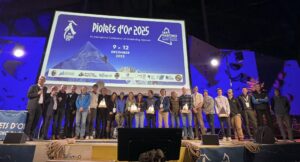After retreating barely 50m below the summit of Peru’s 5,947m Alpamayo, alpinist and writer Michael Levy was looking for something else to climb in the Cordillera Blanca range. Adam Bielecki was waiting to climb a yet to be unveiled Andean project with his Polish team. They accidentally met in Huaraz, and the timing was right.
“I had interviewed him once for a feature on his Nanga Parbat rescue, and then briefly met him a couple of years ago in Poland, that was all,” the Climbing.com editor told ExplorersWeb. “We had never climbed together.”
It went well for a Cita a Ciegas — Spanish for blind date. That is what Bielecki called the 500m-long route that the pair opened on the south face of Janyaraju (approx 5,600m). The difficulty, according to Montagna Magica, is D+, M4 with an average 60°-70° and a maximum 85° slope.

Bielecki (left) and Levy in front of Janyaraju, with the route marked in black and the technical details. Photo: Adam Bielecki
The climb
Micher Quito, one of South America’s leading mountain guides and the man to go for information in Huaraz, suggested the goal because of its short approach. Nevertheless, the trek in “was kind of heinous with our heavy backpacks,” said Levy.
“We camped in this beautiful, beautiful cirque, next to some gorgeous, bigger mountains, such as Oeshapalca [5,888m]. On the next day, July 30, we got up super-early and hiked to the glacier.”
The glacier turned out to be complex to navigate. They even wondered if they’d be able to get to the base of the wall, but they eventually found a way and reached it by 6.30 am.

Adam Bielecki crosses the bergschrund…
“Adam approached the base, crossing a snow bridge over the bergschrund, which gave way right below his feet,” said Levy. “Luckily, I was belaying him and he made it back out okay.”
However, this made them try a slightly different approach.

…and then extracts himself after the snow bridge he was on gave way. Photo: Michael Levy
“We started up a very snowy ramp that made progress slow and miserable,” said Levy. “Then we reached a section of squeaky alpine ice, with some easier mixed climbing. Adam led the three first pitches, including a longer one. Then I took over on a couple of pitches.”

Levy leads one of his pitches, mid-route. Photo: Adam Bielecki
Bielecki led the final pitch, which was also the crux of their route because of “the really powdery sugar snow, standing somehow against the laws of physics and glued to this rock slab at the top,” said Levy.
“Adam then slid on the rock slab, yelling at me to prepare for him to take a fall — pretty exciting. And finally, below the summit ridge, he literally dug a diagonal tunnel in the snow. Really wild!”

Adam Bielecki on the final pitch before the summit ridge. Photo: Michael Levy
Checking pictures from past years, Levy reckoned that the new route they had just climbed might not have been doable in drier years when the face was much rockier. This season, however, the Andean “nevados” were well-covered. Likewise, on most of their route, a layer of ice coated the rock, allowing them to follow a logical, direct way to the ridge.

A rappel on the summit ridge during the descent. Photo: Adam Bielecki
“From the ridge, we traversed to the main summit and beyond to a lower col, in order to rappel down an easier route back to the glacier,” Levy said.
Levy admits that there are harder routes and higher mountains around, but their new line was a piece of “good, engaging climbing” on a beautiful, lonely little summit. It also featured views of the “huge, inspiring, daunting” Oeshapalca.

Michael Levy studies Oeshapalca and thinks: “Hey, that’s the one I wanna climb next year!” Photo: Adam Bielecki
As for roping up with Bielecki, “it was so much fun,” said Levy. “[Bielecki] let me lead a couple of the more technical pitches…and he is a brilliant, very, very good technical climber. When he led, he showed his incredible fitness, racing up the face. When it was my turn, I think I slowed him down a bit, but he forgave me.”
The place
For Levy, who climbs regularly in the Lower 48, Alaska, and the Alps, this first trip to the Peruvian Andes opened a new horizon.
He cites the Pou Brothers and Andres Marin as examples of the region’s potential, “just by going a little further off the beaten track”.
Speaking of Iker and Eneko Pou, they reported today that they have opened a third new route in Peru: a 6C, 450m route they call “Super Canalizos” on Huanka Punta.
“Before heading for Alpamayo, we acclimatized with some sport climbing at Hatun Machay, an awesome place at 4,200m they call the rock forest,” Levy explained. “There, we ran into Colin Haley and Melissa Le Neve.”
No one else was there. Then they hired some mules to carry their gear to the higher altitudes and Alpamayo Base Camp.

Hatun Machay’s rock forest. Photo: Share-explore
Levy said that hikes are typically quite short, with base camps reachable in one or two days. The climbing ranges from moderate snow slogs such as Pisco or Huascaran to world-class, technical 6,000’ers.
“What blew me away is how amazing the weather is,” Levy said. “Peru was bright blue skies nearly every single day.”

The snowy section on the lower part of Cita a Ciegas. Photo: Michael Levy






